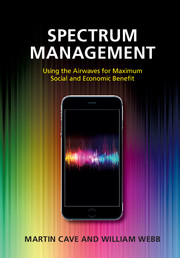Book contents
- Frontmatter
- Contents
- Preface
- Acknowledgments
- Plan of the book
- List of abbreviations
- Part I Fundamentals
- 1 Spectrum management around the world
- 2 The technical challenge
- 3 The economic challenge: a basic primer on spectrum economics
- Part II Economic management of spectrum
- Part III Sharing and other emerging approaches to spectrum management
- Part IV Case studies and conclusions
- About the authors
- Index
- References
2 - The technical challenge
from Part I - Fundamentals
Published online by Cambridge University Press: 05 November 2015
- Frontmatter
- Contents
- Preface
- Acknowledgments
- Plan of the book
- List of abbreviations
- Part I Fundamentals
- 1 Spectrum management around the world
- 2 The technical challenge
- 3 The economic challenge: a basic primer on spectrum economics
- Part II Economic management of spectrum
- Part III Sharing and other emerging approaches to spectrum management
- Part IV Case studies and conclusions
- About the authors
- Index
- References
Summary
Introduction
The most fundamental reason for managing radio spectrum is to avoid interference between users, or at least to ensure interference is manageable and optimizes the capacity of the radio spectrum. This chapter provides the background material necessary to understand how interference occurs and the mechanisms to mitigate its effects. This is fundamental to the understanding of the spectrum management discussions throughout the rest of this book.
The chapter broadly describes the characteristics of a radio signal, how it travels from a transmitter to a receiver, the ways that interference can occur in the receiver, and how these can be avoided using technology.
Transmitting a radio signal
Defining a radio signal
A radio signal is the emission of an electromagnetic wave from an antenna. Electromagnetic waves cover a broad range of frequencies, from radio waves up through visible light and beyond into X-rays. Radio waves are generally considered to be those where the frequencies range from around 10 kHz up to 300 GHz. They are formed when an electrical signal passes into any conductor that has the ability to radiate signals. Antennas are designed for this purpose, but cabling can be an unwanted radiator if not properly shielded, and even semiconductor chips tend to radiate unwanted signals.
Components of a signal: power, bandwidth, and mask
At its simplest a radio signal has three key components – power, bandwidth and frequency. The power is the amount of energy radiated from the antenna, typically measured in watts. The bandwidth is the width of the different frequency components of the signal, measured in hertz, and the center frequency is the frequency of the transmitter when not transmitting any information (said to be unmodulated), also measured in hertz. For example, a GSM handset might transmit 1 W of power at a center frequency of 900 MHz with a bandwidth of 200 kHz.
As might be expected, there are some subtleties in each of these parameters. The antenna used by a device can radiate energy equally in all directions (an “omnidirectional antenna”) or it can focus energy in one particular direction (a “directional antenna”). The former is like a light bulb in a room, the latter like a torch. The effect of a directional antenna is to increase the energy received in the direction of the beam and decrease it elsewhere.
Information
- Type
- Chapter
- Information
- Spectrum ManagementUsing the Airwaves for Maximum Social and Economic Benefit, pp. 24 - 41Publisher: Cambridge University PressPrint publication year: 2015
